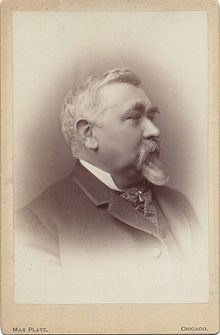Hermann Raster
| Hermann Raster | |
|---|---|
 |
|
| Collector of Internal Revenue for the 1st District of Illinois | |
|
In office March 10, 1871 – March 30, 1872 |
|
| Preceded by | Edmund Jüssen |
| Succeeded by | Samuel A. Irvin |
| Personal details | |
| Born | May 6, 1827 Zerbst, Anhalt-Dessau |
| Died | July 24, 1891 (aged 64) Kudowa-Zdrój, Province of Silesia, German Empire |
| Resting place | Graceland Cemetery |
| Political party | Democrat (1851-1854), Republican (1854-1891) |
| Spouse(s) | Margarethe Oppenheim |
| Children | Mathilde Raster, Anna Sophie Hercz, Edwin Otto Raster, Walther Berthold Raster |
| Alma mater | University of Leipzig, University of Berlin |
| Profession | Editor, Writer, Politician, Stenographer |
| Religion | Christian |
| Signature |  |
Hermann Raster (May 6, 1827 – July 24, 1891) was a German American Forty-Eighter, editor, abolitionist, and politician best known for his career as chief editor for the Illinois Staats-Zeitung between 1867 and 1891 and his brief term as Collector of Internal Revenue for the 1st District of Illinois.
Raster was born in Zerbst, Anhalt-Dessau on May 6, 1827 to a family of aristocrats. His father, statesman Christian Raster was the Administrative Officer and close friend of the Duke of Anhalt, Leopold IV. Hermann was one of eight children, his siblings in order being Luise, Alexander, Wilhelm, Gustav, (then Hermann) Askan, Wolfgang, and Sophie. Christian insisted young Hermann learned English and had a tutor brought from England to teach him. By the time Hermann was an adult he was fluent in seven languages. He graduated from the University of Leipzig in 1846 and then the University of Berlin in 1848. In 1849 he took a job as the stenographer of the Anhalt Legislature. He was very involved with the German liberal political scene of the late 1840s and in 1848 was named Secretary of the State Assembly of Dessau. In 1851, he was forced to leave Germany or face trial for his actions.
Hermann arrived in New York City in July, 1851 and first found employment as a wood-chopper at a farm near Tioga, Pennsylvania. He left for Buffalo in the spring of 1852, accepting the position of editor for the Buffalo Demokrat. His journalistic reputation grew quickly and in February 1853, Raster was made editor of the New York Abendzeitung, the most influential German-language paper of the time. He had a wife, Emilia Berta Hahn Raster, born in 1836, and a daughter, Mathilde, with her in 1857. While living in New York, he became an active member of the Republican Party. In 1856, he became an elector in the 1856 presidential election. Raster was influential in leading the German-American switch to the Republican Party in 1856, swaying German public opinion via his pro-union, anti-slavery articles in the German press, and promoting the personal liberty cause. He was a very strong supporter of Abraham Lincoln and helped convince the German and European communities to vote Republican. His wife, Emilia, died on October 14, 1861, at the age of 25, of an unknown cause. She is interred at Evergreens Cemetery in New York. During the American Civil War, he was the primary American correspondent for the newspapers in Berlin, Bremen, Vienna, and other Central European cities, and was regarded as more effective in campaigning for the American cause in Germany than any politicians at the time. Up until 1867 he was also the Wagonmaster of the United States Custom House (New York City).
...
Wikipedia
